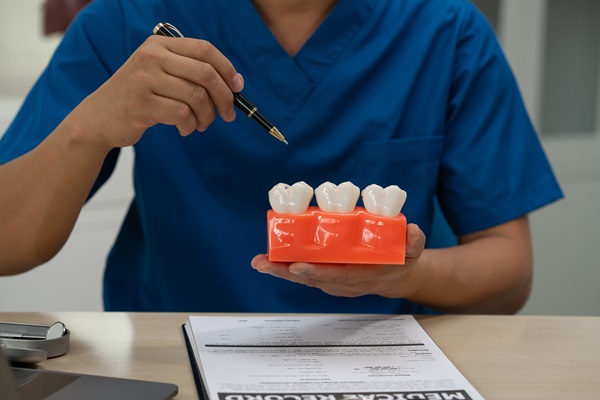A Procedure Guide to Getting a Dental Implant

You can get a dental implant (or multiple dental implants) in less than six months. While many patients understand the benefits of a dental implant, many often avoid treatment out of fear that the process is too invasive or takes too long. This review explains what you can expect throughout the treatment process.
How the treatment process works when getting a dental implant
Getting a dental implant often involves a consultation to determine what preparation is necessary, the implant placement procedure, recovery after implant placement, placement of the abutment and artificial tooth and routine dental visits. The length of time for each step varies, and the entire process takes anywhere from four months to more than a year.
The consultation visit
The first visit with a dentist for dental implant treatment involves a review of the patient’s medical history and the purpose of their visit. It also involves a thorough oral examination and dental X-rays, which are used to determine if the patient is ready for implant placement or if they need procedures to prepare the mouth. Some patients require treatment for periodontal disease or a bone grafting procedure to address bone loss before the implant placement procedure. A detailed treatment plan is put together during the consultation visit.
The implant placement procedure
The implant placement procedure is scheduled once the patient has good oral health and there is enough healthy jawbone to support the implant. The procedure is sometimes performed by the dentist, although many refer the patient to an oral surgeon for implant placement. It involves accessing the underlying bone beneath or above the missing tooth and fixing the implant securely into the jaw.
Recovering after implant placement
The patient is under anesthesia during implant placement, so there is no discomfort during the procedure itself. However, there is often swelling and minor pain during the recovery process. While recovering, the patient should follow all the dentist’s instructions, practice good oral hygiene and eat a soft diet that does not contain sugar.
Placing the abutment and artificial tooth
Once the mouth heals, which typically takes a couple of months, a follow-up procedure is scheduled to place the abutment and the artificial tooth. This is a less invasive procedure that does not require a long recovery time. For single tooth replacement, the dentist will likely use a dental crown, whereas a bridge or implant-supported denture is used for multiple teeth replacement.
Routine dental visits and at-home care
After treatment, most patients are encouraged to visit the dentist for regular check-ups. This ensures that there are no setbacks and allows the dentist to address any oral health concerns that are not directly related to the dental implant.
Start the dental implant process with a consultation
We encourage anyone with one or more missing teeth who wants a long-term and reliable solution to call us or send us an email. We can arrange a consultation, during which we can discuss treatment goals and help you decide if dental implant treatment is the right choice for you.
Are you considering a dental implant in the Silverdale area? Get more information at https://clearcreekdentistry.net.
Check out what others are saying about our dental services on Yelp: Dental Implant in Silverdale, WA.
Recent Posts
Dental implants are a great way to replace multiple missing teeth. A dental bridge is also a solution for multiple teeth replacement in many cases as well. By learning more about the pros and cons of each option, it will help you decide which treatment option is right for you. Missing teeth create a cosmetic, functional…
Talk to any dentist about missing teeth solutions and dental implants will be one of the first options they bring up. There are many good reasons for this. Implants are the only oral prosthetic that replaces missing teeth roots and they prevent the bone tissue loss that normally takes place when you lose some of…
Thinking about choosing dental implants to address your missing teeth problem? Even missing just one tooth can cause someone to experience multiple dental problems, e.g., shifting teeth, headaches, uneven tooth wear. According to the American Dental Association, the average adult between the ages of 20 and 64 has three or more decayed or missing teeth.Understanding…
No one should have to live with missing teeth, and if you are not comfortable wearing dentures, then dental implants may be the best way for you to replace one or more missing teeth. Learn more about how dental implants are placed before deciding if you should visit a dentist for implant treatment. Dental implants require…


